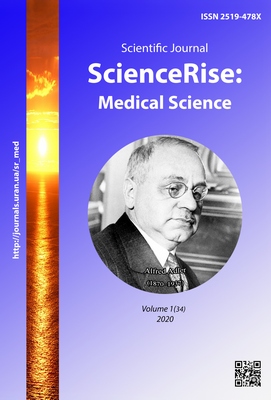Morphometric parameters of hepatocytes in experimental complete extrahepatic bile duct obstruction
DOI:
https://doi.org/10.15587/2519-4798.2020.193845Keywords:
experimental biliary tract obstruction, cholestasis, hepatocyte, liver morphology, morphometryAbstract
Liver changes observed in complete extrahepatic bile duct obstruction (CEBDO) with consideration to its morphometric parameters, may reflect the upcoming decompensation of liver function and may serve as objective criteria for the disease prognosis.
The aim. To study the morphological changes of hepatocytes in experimental CEBDO using macro- and micromorphometry.
Materials and methods. In 41 rats, the CEBDO was done by ligation and transection of the common bile duct. The time points were on postoperative Day 1, 3, 7, 14, 21, 28 and 35. Control group included 10 non-operated rats. The total blood bilirubin (TB), liver volume (LV), the area of hepatocytes (AH), the hepatocyte nuclear-cytoplasmic ratio (HNCR), the hepatocyte bulk density (HBD) were investigated. The LV and HBD parameters were used to calculate the total volume of hepatocytes (TVH).
Results. The highest mortality was recorded on Day 22-35 of the experiment (7 out of 11 animals). Bilirubin level was significantly higher than in the control group with its maximum on Day 1 (295±100 vs. 8±6, μmol/l, p<0.001). The highest LV value was observed on Day 14 (14.1±1.1 vs. 8.4±1.4cm³, p<0.01). The processes prevailing in the livers were cell proliferation, fibrosis with gradual displacement of hepatocytes by proliferating bile ducts, and complete loss of normal liver histostructure. The proportion of hepatocytes in the liver (HBD) was progressively decreasing from 0.94 (Control) to 0.44 (Day 35). In spite of that, the TVH level was initially increased (max 9.7±0.36cm³ on Day 3 vs. 8.3±0.26cm³ on Day 1, p<0.05), but after Day 14 it decreased, with no significant differences from the Control group on Day 21(8.2±1.2 vs. 7.9±1.6cm³, p>0.05), with its lowest level (5.0±0.9cm³) on Day 35 (p<0.05 compared with max value on Day 3). The HNCR index, which reflects proliferative activity of hepatocytes, had its maximum on Day 14 (0.53±0.01 vs. 0.21±0.05 in Control group, p<0.001).
Conclusions. In experimental CEBDO, reduction of the HBD index less than 60 % and reduction of TVH less than the value of a normal liver are accompanied by highest mortality, i.e., are a sign of hepatic decompensation. That was preceded by the maximum proliferative activity of hepatocytes, the criterion of which is the HNCR index
References
- Wu, W., Yang, Y., Huang, Q. (2001). Bilirubin metabolism after obstructive jaundice in rats. Zhonghua Gan Dan Wai Ke Za Zhi, 5, 288–291.
- Marques, T. G., Chaib, E., Fonseca, J. H. da, Lourenço, A. C. R., Silva, F. D., Ribeiro Jr, M. A. F. et. al. (2012). Review of experimental models for inducing hepatic cirrhosis by bile duct ligation and carbon tetrachloride injection. Acta Cirurgica Brasileira, 27 (8), 589–594. doi: http://doi.org/10.1590/s0102-86502012000800013
- Dondorf, F., Fahrner, R., Ardelt, M., Patsenker, E., Stickel, F., Dahmen, U. et. al. (2017). Induction of chronic cholestasis without liver cirrhosis – Creation of an animal model. World Journal of Gastroenterology, 23 (23), 4191–4199. doi: http://doi.org/10.3748/wjg.v23.i23.4191
- Wright, J. E., Braitwaite, J. L. (1964). The effects of ligation of the common bile duct in the rat. Journal of Anatomy, 98 (2), 227–233.
- Matenaers, C., Popper, B., Rieger, A., Wanke, R., Blutke, A. (2018). Practicable methods for histological section thickness measurement in quantitative stereological analyses. PLOS ONE, 13 (2), e0192879. doi: http://doi.org/10.1371/journal.pone.0192879
- Heinrich, S., Georgiev, P., Weber, A., Vergopoulos, A., Graf, R., Clavien, P.-A. (2011). Partial bile duct ligation in mice: A novel model of acute cholestasis. Surgery, 149 (3), 445–451. doi: http://doi.org/10.1016/j.surg.2010.07.046
- Prigge, J. R., Coppo, L., Martin, S. S., Ogata, F., Miller, C. G., Bruschwein, M. D. et. al. (2017). Hepatocyte Hyperproliferation upon Liver-Specific Co-disruption of Thioredoxin-1, Thioredoxin Reductase-1, and Glutathione Reductase. Cell Reports, 19 (13), 2771–2781. doi: http://doi.org/10.1016/j.celrep.2017.06.019
- Tietz, N. W. (Ed.) (1995). Clinical guide to laboratory tests. Philadelphia: WB saunders, 268–273.
- Yang, Y., Chen, B., Chen, Y., Zu, B., Yi, B., Lu, K. (2014). A comparison of two common bile duct ligation methods to establish hepatopulmonary syndrome animal models. Laboratory Animals, 49 (1), 71–79. doi: http://doi.org/10.1177/0023677214558701
- Ertor, B., Topaloglu, S., Calik, A., Cobanoglu, U., Ahmetoglu, A., Ak, H. et. al. (2013). The Effects of Bile Duct Obstruction on Liver Volume: An Experimental Study. ISRN Surgery, 2013, 1–7. doi: http://doi.org/10.1155/2013/156347
- Kordzaia, D., Jangavadze., M. (2014). Unknown bile ductuli accompanying hepatic vein tributaries (experimental study). Georgian Med News, 234, 121–129.
- Mamontov, I. М., Ivakhno, I. V., Tamm, T. I., Panasenko, V. O., Padalko, V. I., Zulfugarov, I. (2019). Morphological signs of the hepatic function decompensation with experimental complete obstruction of the extrahepatic bile ducts. World of Medicine and Biology, 15 (67), 162–166. doi: http://doi.org/10.26724/2079-8334-2019-1-67-162
Downloads
Published
How to Cite
Issue
Section
License
Copyright (c) 2020 Ivan Mamontov, Igor Ivakhno, Tamara Tamm, V’yacheslav Panasenko, Volodymyr Padalko, Ismat Zulfugarov

This work is licensed under a Creative Commons Attribution 4.0 International License.
Our journal abides by the Creative Commons CC BY copyright rights and permissions for open access journals.
Authors, who are published in this journal, agree to the following conditions:
1. The authors reserve the right to authorship of the work and pass the first publication right of this work to the journal under the terms of a Creative Commons CC BY, which allows others to freely distribute the published research with the obligatory reference to the authors of the original work and the first publication of the work in this journal.
2. The authors have the right to conclude separate supplement agreements that relate to non-exclusive work distribution in the form in which it has been published by the journal (for example, to upload the work to the online storage of the journal or publish it as part of a monograph), provided that the reference to the first publication of the work in this journal is included.









